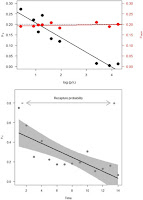Tavecchia, G., Gimenez, O., Choqut, R., Oro, D., Tenan, S. and Sanz-Aguilar, A. 2021.The trap of hidden processes: Why ‘quick & dirty’ methods to estimate mortality are not always good. A comment to De Pascalis et al. (2020) Biological Conservation, 109057, doi: 10.1016/j.biocon.2021.109057
CMRR models can be difficult to build and many conservation biologists are tempted to shortcut them for simpler, ‘quick & dirty’, methods, trading difficulty with the lack of precision. In some particular cases, it is a winning trade, however, in most cases, it is a very hazardous practice. The proportion of animal seen alive vs those seen dead depends, by definition, on the detection probability, p, that an animal alive is detected and on the probability, λ, that a dead animal is found or retrieved (c) and the tag reported (r), with λ = c*r. Not taking thi into acocunt would lead to biased estimates. Explore scenarios through an R shiny application provided at https://github.com/oliviergimenez/bias_recovery.












